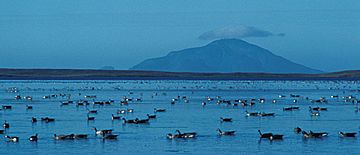Amak Volcano facts for kids
Quick facts for kids Amak Volcano |
|
|---|---|

Amak Island and volcano at top
|
|
| Highest point | |
| Elevation | 1,601 ft (488 m) |
| Geography | |
| Parent range | Aleutian Islands |
| Geology | |
| Mountain type | Stratovolcano |
| Volcanic arc | Aleutian Arc |
| Last eruption | 1796 |
Amak Volcano is a type of volcano called a stratovolcano. It's made of basaltic andesite rock. You can find it in the Aleutian Islands of Alaska, USA. It's about 618 miles (995 km) away from Anchorage.
This volcano sits on Amak Island. The island is about 31 miles (50 km) from Frosty Peak Volcano. It's also close to the western edge of the Alaska Peninsula. To visit Amak Island, you need a special permit and can only go by boat.
The volcano has lava flows that look "blocky." This means they have flat blocks of minerals and crystals. These flows stretch from the top of the volcano down its sides. Amak Volcano has erupted three times in recorded history. Two of these eruptions happened in the 1700s. The first was between 1700 and 1710, and the second was in 1796. Scientists think the earliest eruption happened much longer ago, between 3050 and 2050 BCE.
Contents
How to Visit Amak Volcano
The closest city to Amak Island is Cold Bay. You can easily get to Cold Bay by plane. However, you can only reach Amak Island by boat. Airplanes are not allowed to land on the island.
You can find private boat rides to Amak Island from Cold Bay. But remember, to visit any of the Aleutian Islands, you need a permit. You can get this permit from the United States Fish and Wildlife Service.
About Amak Island's Location and Rocks
Amak Island is located in the Bering Sea. This is north of the main group of islands that make up the Aleutians. Amak is one of only two islands that are about 31 miles (50 km) north of the main island chain. The other island is Bogoslof Island.
The United States has many active volcanoes. Most of them are quite new in terms of geology. In Alaska, at least 50 volcanoes have erupted in recorded history. This includes those in the Aleutian Islands. Alaska has about 80% of all the volcanoes in the United States. This doesn't count the underwater mountains called seamounts. Most of these volcanoes are in the Aleutian Islands. The Aleutian Islands form the northern edge of the Pacific Ring of Fire. This is an area where lots of earthquakes and volcanic eruptions happen.
What Amak Volcano is Made Of
Amak Volcano is made of a type of rock called basaltic-andesitic rock. It's not a very tall stratovolcano, rising about 1,683 feet (513 m) above sea level. The volcano has a clear crater at its top. When it has erupted in the past, it has only produced "blocky" lava flows.
Two scientists, Charles Wood and Jürgen Kienle, who study volcanoes, think that earlier eruptions (about 4,000–5,000 years ago) mostly produced thin, flat lava and thick andesite lava. Amak Volcano is special because its andesite lava has a lot of potash. This is unusual for Aleutian volcanoes. Its lava might also have more sodium carbonate and rare-earth elements than other volcanoes in the Aleutians. Compared to Bogoslof, the other Aleutian island north of the main chain, Amak's lavas are more alkalic (meaning they have more alkali metals) and silicic (meaning they have more silica).
About 6,700 years ago, glaciers were around the volcano. They carved out U-shaped valleys. On the southwest side of the island, you can find a crater. It's probably a maar, which is a wide, flat-bottomed volcanic crater. This crater is in an alluvial plain, which is a flat area formed by flowing water.
When Amak Volcano Has Erupted
Amak Volcano has erupted three times in recorded history:
- Around 2550 BC (this was found using a method called tephrochronology, which studies ash layers).
- From 1700 to 1710.
- In 1796.
Each of these eruptions involved lava flows. The two most recent eruptions also included lava coming from the crater itself.
See also
 In Spanish: Monte Amak para niños
In Spanish: Monte Amak para niños



